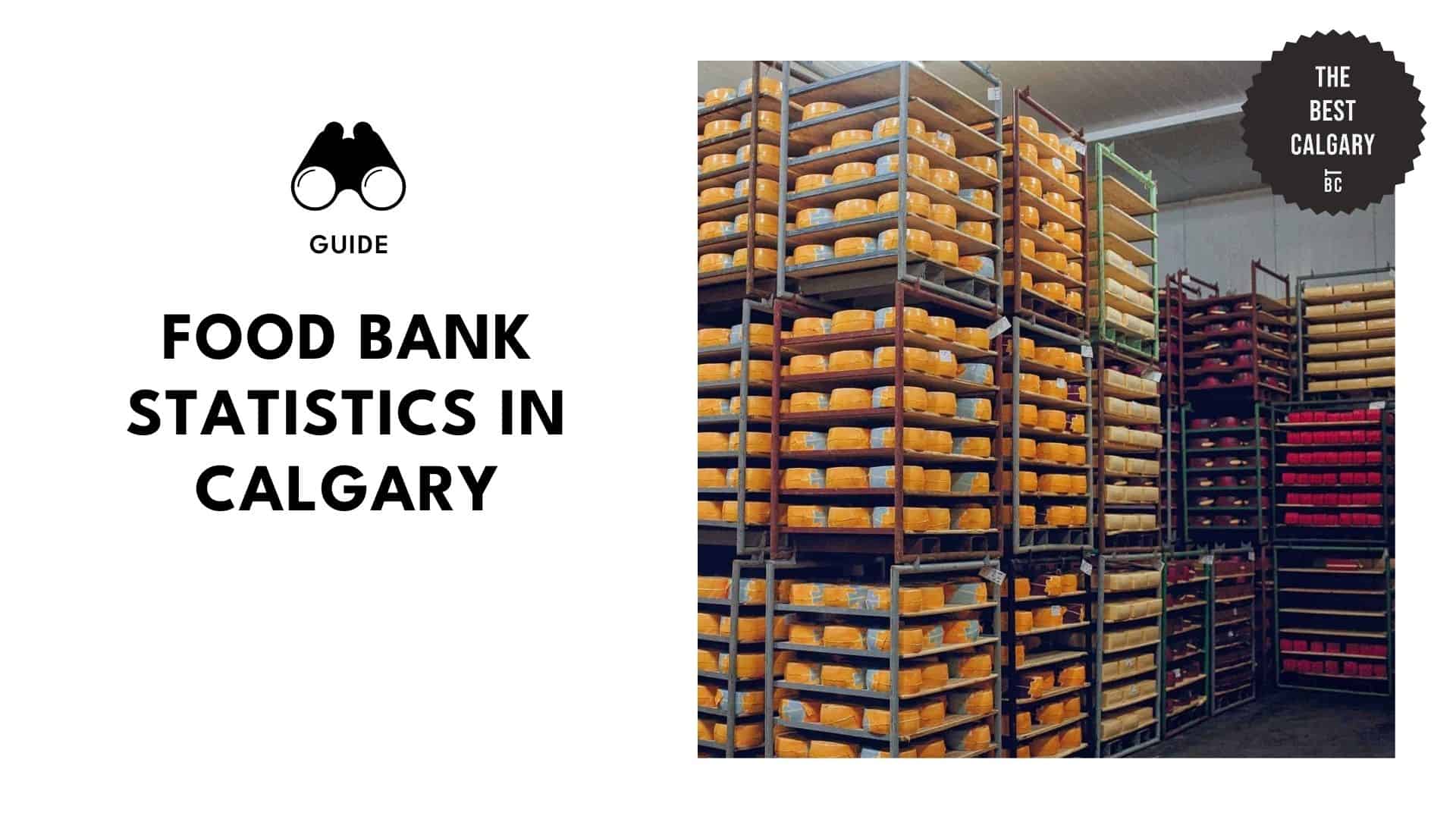Tracking Calgary’s Food Bank Statistics: Trends and Solutions
Key Insights
| The Calgary Food Bank reports that they supplied 149,909 food hampers from September 2022 to August 2023, which provided a total of 1,320,635 pounds of food valued at $4,263,848. The same report also shows that their industry partners contributed another 13,327,753 pounds of food, which was totalled at $41,815,532. Data from Food Banks Canada reveals that in 2023, Alberta had 172,832 food bank visits, and 61,379 of these visits were from children. According to the Calgary Food Bank, unemployed individuals make up a total of 20% of their recipients. A study by the Breakfast Club of Canada indicates that childhood hunger negatively affects the academic performance of children. |
Data from the Calgary Food Bank shows that food security in the city continues to be a growing problem, with food assistance demand rising across different groups.
From September 2022 to August 2023, the Calgary Food Bank supplied 149,909 hampers through all of its programs, providing emergency food relief to individuals and families in need.
In addition to this, the agency also provided 1,320,635 pounds of food through 56 partners, with a food value totaling $4,263,848. These numbers highlight the increasing reliance on food banks as households struggle to afford basic necessities.
Meanwhile, donations from food industry partners continue to be the foundation of the food bank’s work. More than 91% of all food donations were provided by 360 food industry partners, totaling 13,327,753 pounds of food worth $41,815,532.
This network of partners plays an important role in sustaining the food bank’s operations as they ensure a steady flow of resources to meet the growing demand for food aid.
Beyond food support, it also linked 4,780 individuals to 93 programs of assistance provided through 62 community partners. This is also an indication of increased demand for services beyond direct food assistance.
As food costs continue to rise and economic difficulties persist, demand for food bank services continues to grow in Calgary.
| Hampers supplied by the Calgary Food Bank from September 2022 to August 2023 | 149,909 hampers |
| Total Food Weight Donated | 1,320,635 pounds |
| Total Food Value | $4,263,848 |
| Donations from Partners | 91% were provided by 360 food industry partners13,327,753 pounds of food donated $41,815,532 total food value |
| Programs of Assistance | Linked 4,780 individuals to 93 programs of assistance |
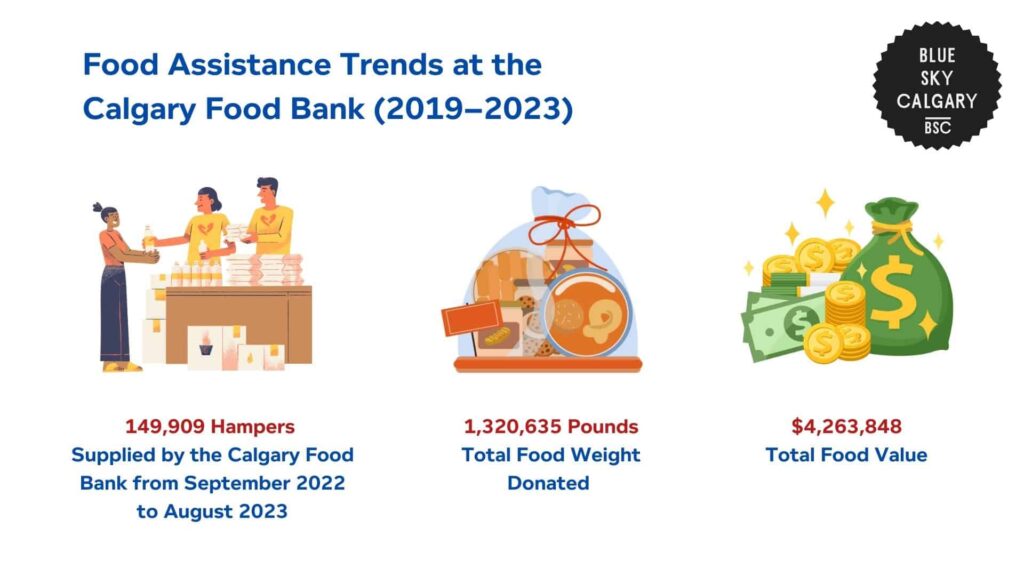
Reasons for Food Bank Usage in Calgary
The Calgary Food Bank shows that without work or proper financial support, many individuals resort to food banks for short-term assistance while searching for new employment.
For example, 20% of the food bank’s recipients declared that they are unemployed or actively seeking employment.
This shows that job loss continues to be a major cause of food insecurity, as those without a steady income tend to find it difficult to meet daily living costs.
However, food insecurity is not limited to individuals without employment. Another 16% of food bank recipients are also fully employed but still in need of food aid.
This shows that many recipients experience poverty while working, as salaries are not able to keep up with the pace of inflation and the cost of living in Calgary.
Additionally, 24% of the food bank’s recipients visit the food bank due to a dependency on fixed government benefits. This includes those relying on pensions, disability support, and other forms of social assistance.
This implies that social assistance programs, pensions, and disability support are not enough to offer financial security for basic needs. This then causes many recipients to turn to supplementary food aid like the food bank.
| Percentage of Food Bank Recipients | Description |
| 20% | Unemployed or actively seeking employment |
| 31% | Employed |
| 24% | Visit food banks due to dependency on fixed government benefits |
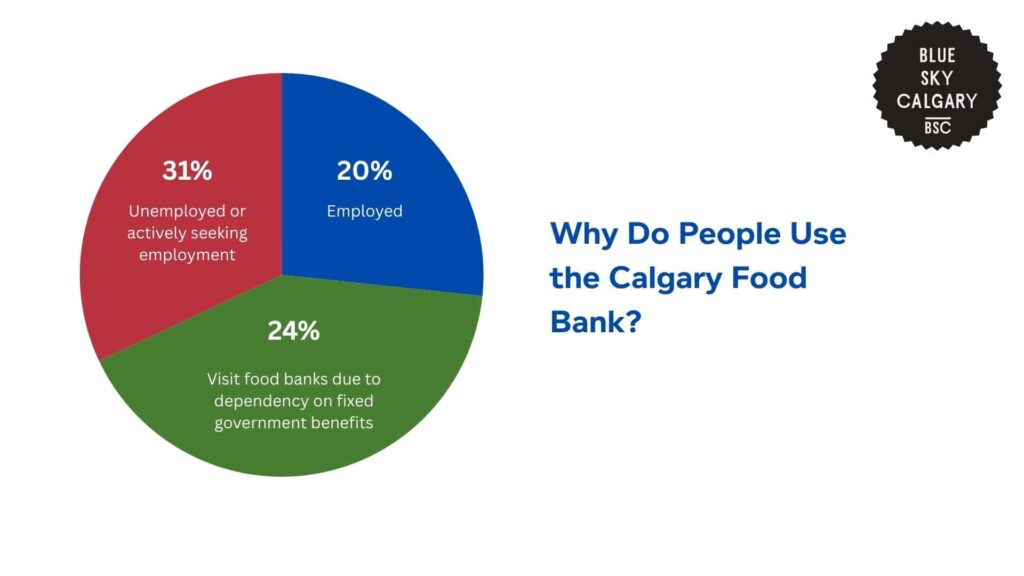
Regional Analysis of Food Bank Visits Across Canada
A report by Food Banks Canada highlights that food bank visits in Canada differ across provinces, with Alberta being one of the top in total visits.
In 2024, Alberta had 172,832 food bank visits, including 61,379 child visits. This high percentage of visits from children, which comprises 35% of all visits, indicates how food insecurity disproportionately affects younger populations.
Even though food bank visits have increased by 92.4% since 2019, Alberta did experience a 0.85% decline from 2023 to 2024, indicating a slight slowing down of food insecurity in the province.
While this decline shows that economic conditions in the city have stabilized to some extent, the overall high numbers of food bank usage point to persistent financial struggles that keep demand high.
Conversely, British Columbia saw an increase of 225,605 food bank visits, which is a 15.15% increase from 2023 to 2024 and an 80.9% increase during the same period.
Furthermore, Ontario and Quebec saw some of the largest food bank visits, with 736,335 and 721,318 visits, which are increases of 116.8% and 109%, respectively, since 2019.
Smaller provinces, such as Saskatchewan (52,877 visits) and Manitoba (55,487 visits), saw 42.1% and 1% increases since 2019, respectively.
Meanwhile, Yukon, Northwest Territories, and Nunavut reported 3,985 visits, which is much lower than the rest of Canada. This is partly because of smaller populations and remote access issues.
Overall, though, Alberta continues to have one of the highest rates of total food bank visits, particularly for children.
Alberta’s dependence on food banks highlights continued economic hardship in the province, especially with increased living expenses and affordability issues.
| Province/Territory | Total Visits (2024) | Change from 2019 (%) | Change from 2023 (%) |
| Ontario (ON) | 736,335 | 116.80% | 8.08% |
| Quebec (QC) | 721,318 | 109.00% | 5.65% |
| British Columbia (BC) | 225,605 | 80.90% | 15.15% |
| Alberta (AB) | 172,832 | 92.40% | -0.85% |
| Manitoba (MB) | 55,487 | 1.00% | -3.25% |
| Saskatchewan (SK) | 52,877 | 42.10% | -5.16% |
| New Brunswick (NB) | 32,167 | 44.50% | 7.77% |
| Nova Scotia (NS) | 39,360 | 53.60% | 21.11% |
| Newfoundland (NL) | 14,236 | 33.00% | -7.71% |
| Yukon/NWT/Nunavut | 3,985 | N/A | N/A |
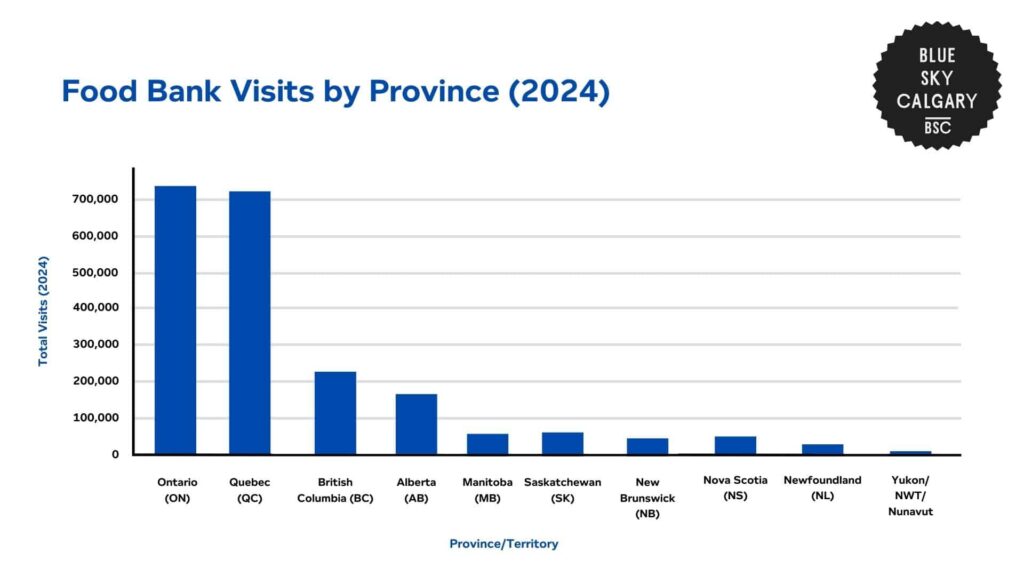
Trends in Food Bank Visits in Calgary
Data from the Calgary Food Bank shows that the rate of food bank visits in Calgary has increased dramatically over the last several years, indicating rising levels of demand for food support.
In 2019, there were 168,110 visits to the food bank, which decreased a little to 165,200 in 2020. This can be attributed to the use of emergency pandemic relief programs that temporarily lowered food bank use.
However, in 2021, visits soared to 221,090, which is an increase of 33.8% over the prior year. This sharp rise indicates that many households continued to experience food insecurity and instability even after pandemic relief programs were rolled out.
This upward trend of food bank visits continued in 2022, with 291,540 visits, which is another increase of 31.9% from 2021.
The growing demand also aligned with rising inflation and increased costs for housing, utilities, and groceries.
Demand further increased in 2023, with visits reaching 381,030, which is an increase of 30.7% over the previous year.
Notably, this rate peaked in 2024, with visits jumping to 485,900. This shows an increase of 27.5% from 2023 and 189% from 2019.
This large growth over a period of just five years shows how economic instability, inflation, and slow income growth have caused more residents to seek emergency relief from the food bank.
Meanwhile, this also indicates worsening economic conditions, like increased living expenses, as more households are finding it difficult to cover basic needs in the city.
| Year | Number |
| 2019 | 168.11K |
| 2020 | 165.2K |
| 2021 | 221.09K |
| 2022 | 291.54K |
| 2023 | 381.03K |
| 2024 | 485.9K |
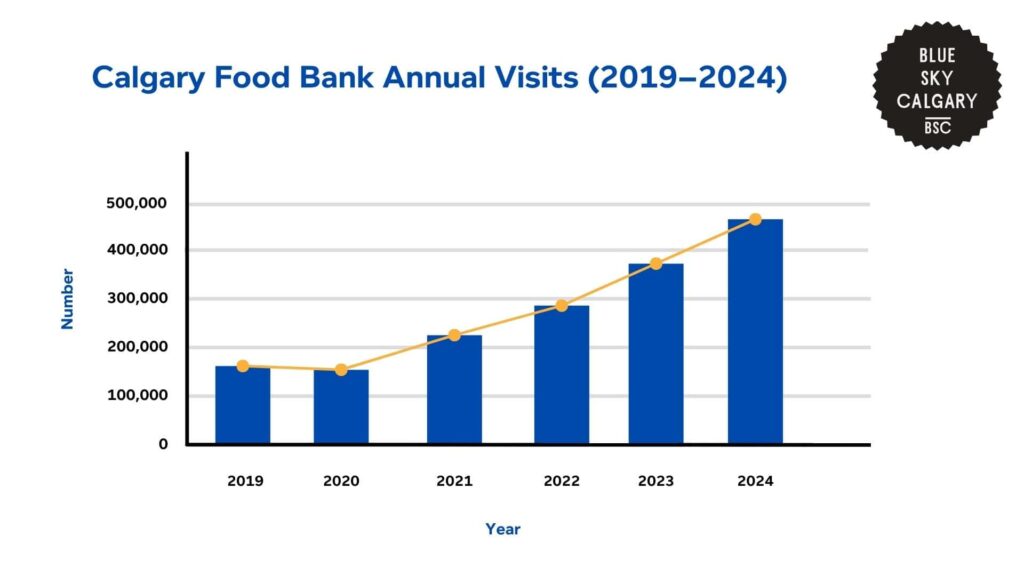
Demographic Breakdown of Food Bank Recipients in Calgary
The Calgary Food Bank shows that their client base is largely composed of families, who make up 64% of the overall clients receiving emergency food hampers.
This high percentage reflects how households with children are the most affected by food insecurity in the city.
As living expenses in Calgary continue to rise, households with more mouths to feed struggle to balance bills for housing and other necessities. This leads them to rely more on food assistance programs for support.
In contrast, only 36% of clients are individuals. This illustrates that single-person households also experience difficulties in terms of food access, although at a smaller rate.
Meanwhile, children account for 34% of food bank users and are among the most at-risk groups for food insecurity.
This large percentage suggests that most families with young children are not able to consistently afford nutritious meals, which has consequences on child development and health.
Similarly, single parents constitute 7% of clients, which illustrates the economic issues faced when raising children alone.
Lacking a second income, the majority of single-parent families face financial instability and find it hard to meet basic expenses, including food.
Additionally, another 4% of food bank recipients are seniors, which also mirrors the challenges of older individuals living on limited pensions or depleted savings.
Seniors are also extra susceptible to hunger because of the cost of health care and other financial pressures.
However, one of the most notable statistics is that 31% of food bank users are working persons, showing that being employed does not always mean that one will be food secure.
Many employed individuals face low wages and rising costs of living, making it difficult to afford basic necessities despite having full-time work.
| Category | Percentage of Recipients |
| Families | 64% |
| Individuals | 36% |
| Working Individuals | 31% |
| Children | 34% |
| Single Parents | 7% |
| Seniors | 4% |
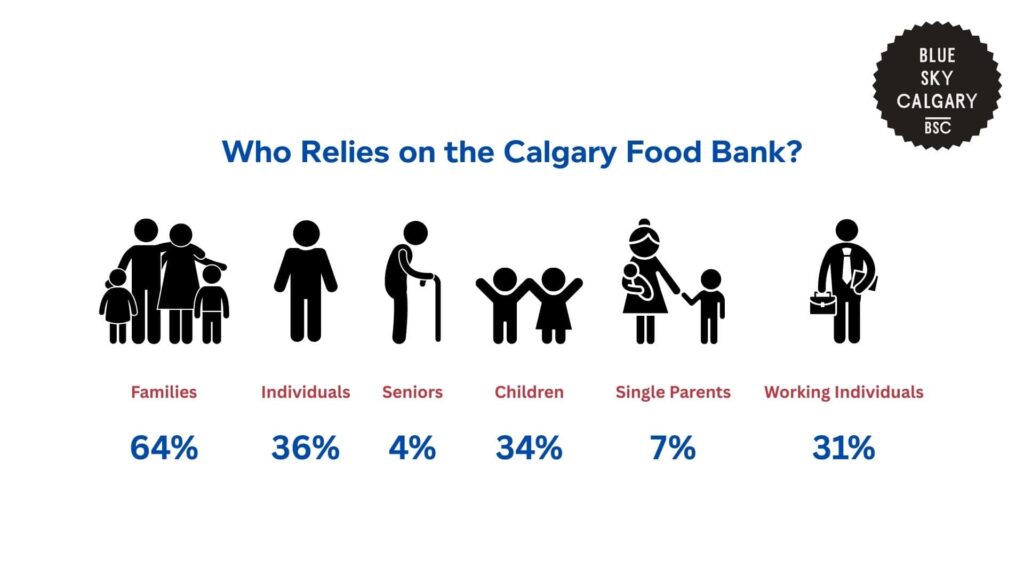
Costs and Consequences of Food Bank Dependence in Calgary
Food Banks Canada explains that the growing dependency on food banks in Calgary is connected to broader issues around economic insecurity.
For example, increased living expenses, stagnant income, and ineffective social safety nets contribute to higher food bank usage.
These factors not only cause more people to seek out food assistance but also place financial strains on both charities and government agencies, who are left to fill the gaps in social welfare and support programs.
Although food banks were originally meant to provide temporary emergency relief, they have become a permanent part of the lives of many individuals.
The Calgary Food Bank, as well as others around the country, is experiencing increased costs related to food acquisition, transportation, and storage.
With food bank visits reaching record high levels, the ability of these facilities to meet the growing demand has become more difficult.
Aside from operational expenses, the social impacts of food insecurity are also evident.
Food insecurity has been identified as a leading cause of high healthcare expenses, as these individuals have a higher tendency to develop chronic conditions like diabetes and heart disease due to the inability to access adequate nutrition.
Moreover, food insecurity is also linked to greater mental illness, such as stress, anxiety, and depression, which may continue to overburden public health systems.
Meanwhile, a study by The Breakfast Club of Canada reveals that hunger has a detrimental effect on the development of children. This shows that children are also disproportionately affected by food insecurity.
This results in poor school performance, which will affect these children even later on in life, especially when attempting to secure higher education or employment.
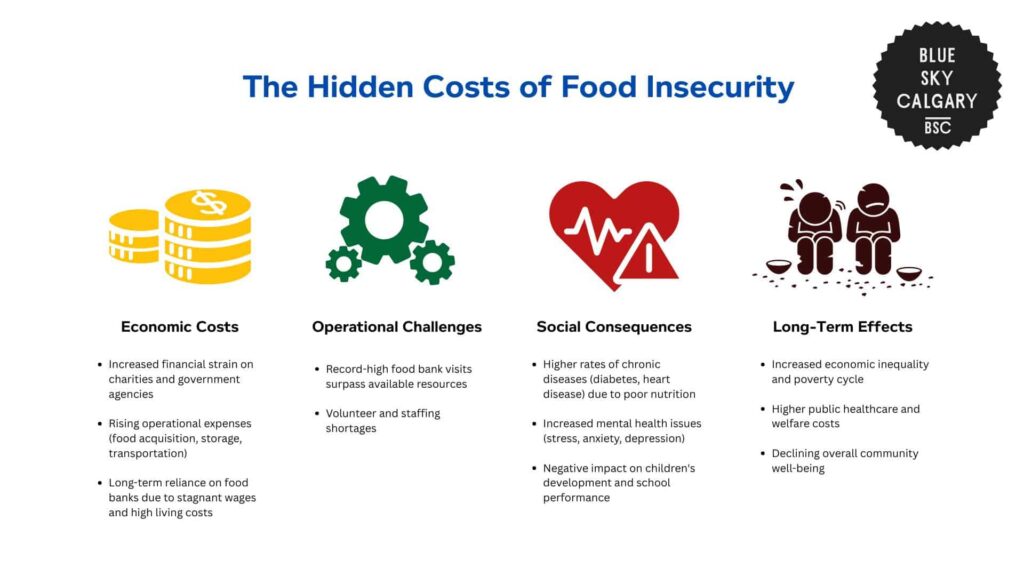
Interventions and Solutions to Food Insecurity in Calgary
While food banks such as the Calgary Food Bank offer important relief for vulnerable groups, there needs to be systematic change to limit reliance on emergency food relief.
Food insecurity can be addressed by moving away from short-term food bank dependence and seeking out long-term solutions.
Thus, financial schemes like the Canada Child Benefit (CCB) and Guaranteed Basic Income (GBI) may give families greater financial security, which then limits their reliance on food banks.
Another solution is investments in affordable housing. This is especially relevant since one of the biggest contributors to food insecurity is high rent prices, which further limits the purchasing power of low-income families.
A study by the Canadian Observatory on Homelessness indicates that expanding the availability of affordable housing programs can ease the financial burden on families, which can later decrease their dependence on food banks.
Locally, food recovery and reduction efforts also aim to narrow the gap between food waste and food insecurity.
Second Harvest Canada is an example of organizations that partner with companies and grocery stores to reroute excess food to marginalized communities, which then reduces food waste while enhancing food access.
Developing partnerships between large food donors and food banks can enhance the provision of healthy foods at no extra cost.
Lastly, nutrition programs in schools have been effective in ensuring children’s food security.
Initiatives such as the Breakfast Club of Canada and school lunch programs ensure regular access to nutritious meals for children.
Overall, focusing on income stability, affordable housing, food redistribution, and child nutrition programs will help Calgary move closer to a more sustainable food system.
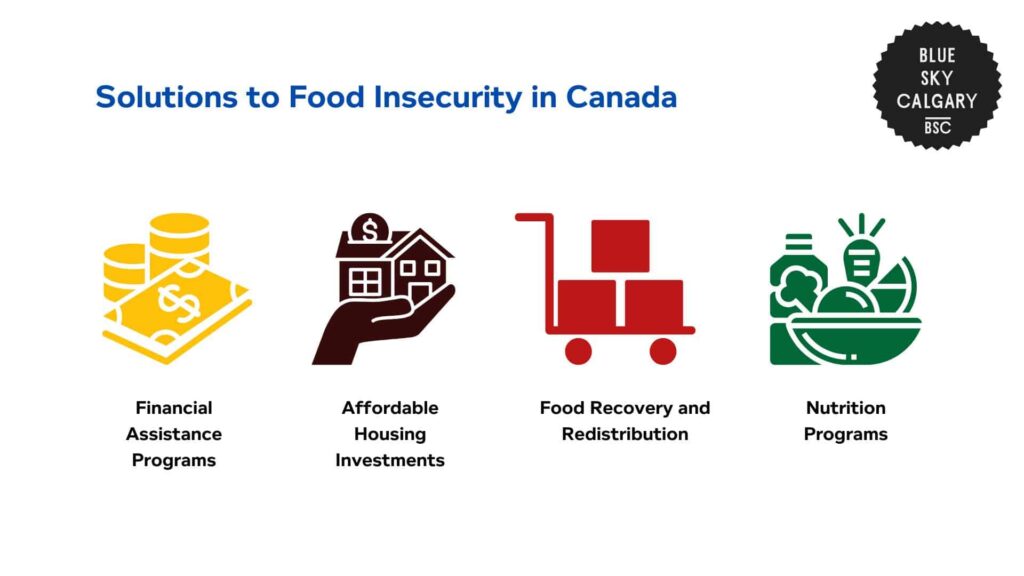
The Future of Food Bank Trends in Calgary
Reliance on food banks in Calgary and throughout Canada is projected to increase, with major economic factors and policies influencing future trends.
Moreover, a sustained increase in working poverty, where working full-time is not enough to cover basic expenses, shows that an increased proportion of working people require food aid.
One of the largest factors behind increased food bank use in the future is the cost of living. If housing costs and inflation remain high while wages are stagnant, there will be more families who cannot afford the basics, thus driving food bank usage higher.
Government policy will be the determining factor addressing these trends of food insecurity.
If income support initiatives are enhanced, dependence on food banks may slowly diminish. These initiatives help families and individuals improve their overall purchasing power, especially for necessities like food.
Although stabilization of demand is possible in the short run, structural issues like increasing living expenses, working poverty, and housing insecurity will continue to drive food insecurity rates.
Without drastic policy reform, food insecurity will likely be a long-term reality, causing food banks to serve as chronic support mechanisms instead of short-term relief agencies.
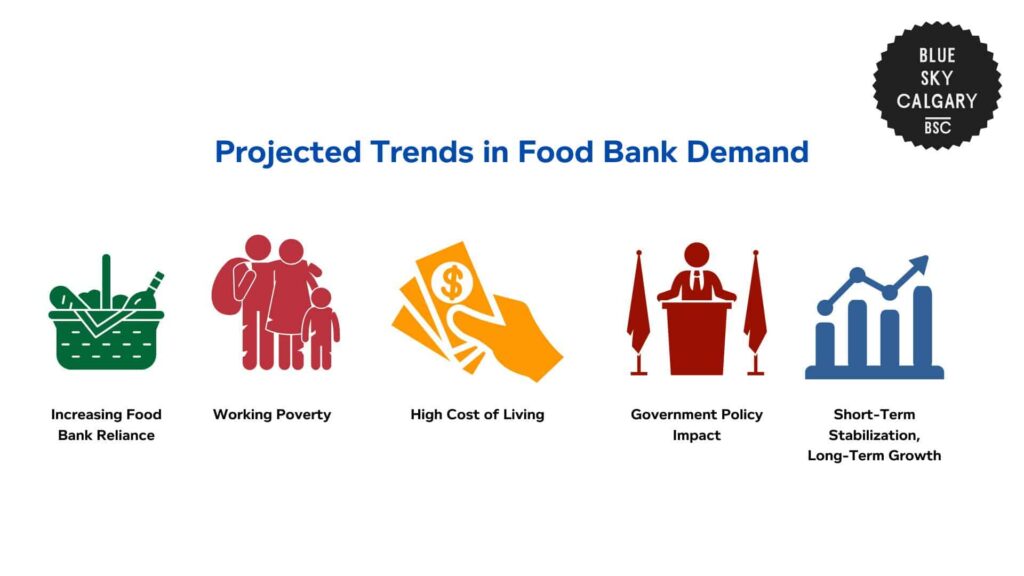
References
- Breakfast Club of Canada. (n.d.). Breakfast Club of Canada. Retrieved March 17, 2025, from https://www.breakfastclubcanada.org/
- Calgary Food Bank. (2015). Fast facts. Retrieved March 17, 2025, from https://www.calgaryfoodbank.com/wp-content/uploads/2015/11/2015-Fast-Facts.pdf
- Calgary Food Bank. (2023). Fact sheet: Annual report 2023. Retrieved March 17, 2025, from https://www.calgaryfoodbank.com/wp-content/uploads/2023/11/CFB-Fact-Sheet-AR-2023.pdf
- Charity Intelligence Canada. (n.d.). Calgary Food Bank. Retrieved March 17, 2025, from https://www.charityintelligence.ca/charity-details/11-calgary-food-bank
- Food Banks Canada. (2024). HungerCount report. Retrieved March 17, 2025, from https://foodbankscanada.ca/hungercount/
- Government of Canada. (2024). Canada child benefit overview. Retrieved March 17, 2025, from https://www.canada.ca/en/revenue-agency/services/child-family-benefits/canada-child-benefit-overview.html
- Homeless Hub. (n.d.). Homeless Hub Canada. Retrieved March 17, 2025, from https://homelesshub.ca/
- Kaufmann, B. (2024, March 5). Calgary Food Bank demand up in 2024. Calgary Herald. Retrieved from https://calgaryherald.com/news/calgary-food-bank-demand-up-2024
- Second Harvest Canada. (n.d.). Second Harvest: Rescuing food and reducing waste. Retrieved March 17, 2025, from https://www.secondharvest.ca/
- The Canadian Press. (2024, February 12). Calgary Food Bank demand surges 200 per cent from pre-pandemic levels. CTV News Calgary. Retrieved from https://www.ctvnews.ca/calgary/article/calgary-food-bank-demand-surges-200-per-cent-from-pre-pandemic-levels/

